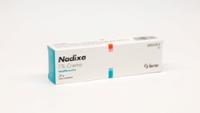

Nadixa 1% crema


Інструкція із застосування Nadixa 1% crema
Введение
Противорецептор: информация для пользователя
Nadixa 1% Крем
nadifloxacino
Читайте весь протокол внимательно до начала использования этого препарата, поскольку он содержит важную информацию для вас.
- Сохраните этот протокол, поскольку может потребоваться повторное его прочтение.
- Если у вас есть какие-либо вопросы, обратитесь к вашему врачу или аптекарю.
- Этот препарат был назначен только вам и не следует давать его другим людям, даже если у них есть одинаковые симптомы, поскольку это может причинить вред.
- Если вы испытываете побочные эффекты, обратитесь к вашему врачу или аптекарю, даже если это побочные эффекты, которые не указаны в этом протоколе.См. раздел 4.
1. Что такое Крем Надикса и для чего он используется
2. Что нужно знать перед началом использования Крема Надикса
3. Как использовать Крем Надикса
4. Возможные побочные эффекты
5. Хранение Крема Надикса
6. Содержимое упаковки и дополнительная информация
1. Что такое Надикса крем и для чего используется
Надикса является антибактериальным средством, которое относится к группе кинолонов.
Надикса используется для лечения легких или умеренных форм воспалительного акне vulgaris (акне папулопустулёзное, степень I-II).
2. Что нужно знать перед началом использования крема Надикса 1%
Не использовать Надикса 1% крем
Если вы аллергины на Надифлоксацин или на любые другие компоненты этого препарата (указанные в разделе 6).
Предупреждения и предостережения
Советуйтеся с врачом или фармацевтом перед началом использования Надикса 1% крема.
Избегайте контакта Надикса с глазами и другими слизистыми оболочками (ротом и носом). Если, несмотря на это, крем попадет в глаза или другие слизистые оболочки, промойте область большим количеством теплой воды.
После применения Надикса крема, помойте руки теплой водой и мылом, чтобы не случайно нанести препарат на нежелательные области.
Известны случаи фотосенсибилизации, развивающиеся во время системного лечения другими кинолонами.. Хотя несколько исследований на животных и людях показали, что Надифлоксацин не имеет фототоксичных и фотоаллергических свойств, основа крема может усиливать фотосенсибилизацию..Кроме того, нет данных о длительном воздействии солнечного света или искусственной УФ-лучевой радиации при использовании Надикса. Следовательно, пациенты, принимающие Надикса, должны избегать, в принципе, воздействия искусственной УФ-лучевой радиации (УФ-лампы, солнечные кабины, солярий) и всегда избегать воздействия солнечного света.
Остановите использование Надикса крема, если появится реакция гиперчувствительности (жжение, раздражение, пузырьки, волдыри) или серьезное раздражение.
Не применять Надикса, если у вас есть открытые раны в области применения.
Дети:
Безопасность и эффективность Надикса не были достаточно оценены у детей младше 14 лет. Следовательно, препарат не должен использоваться у пациентов этого возраста.
Другие препараты и Надикса 1% крем:
Советуйтеся с врачом или фармацевтом, если вы принимаете или недавно принимали любой другой препарат, даже те, которые вы купили без рецепта.
Абсорбция Надифлоксацина после применения Надикса крема на кожу очень низка и, следовательно, маловероятна взаимодействие с другими препаратами, принимаемыми одновременно перорально. Нет никаких данных, указывающих на то, что эффективность системно принимаемых препаратов может быть нарушена использованием Надикса крема.
Надикса может вызвать усиление раздражения кожи, если его применять одновременно с другими продуктами, содержащими пилингирующие, астингентные и/или раздражающие вещества (спирты, ароматические агенты).
Беременность и лактация:
Если вы беременны или кормите грудью, если вы думаете, что можете быть беременны или планируете беременность, советуйтесь с врачом или фармацевтом перед использованием этого препарата.
Нет данных о клинических исследованиях о влиянии Надифлоксацина на беременных женщин.
В исследованиях на животных было показано, что нет риска тератогенности или других негативных эффектов на развитие плода.
Однако Надикса следует использовать только во время беременности после тщательного оценки врачом потенциальных преимуществ для матери и потенциальных рисков для развития плода.
Известно, что Надифлоксацин выделяется в грудном молоке, поэтому Надикса крем не следует использовать во время лактации. Женщины, кормящие грудью, не должны наносить Надикса на грудь в любом случае.
Вождение и использование машин:
Необходимы особые предостережения..
Надикса 1% крем содержит этиловый стеарат, этиловый цетиловый спирт и хлорид бензалкония:
Этот препарат может вызвать местные реакции на кожу (как дерматит контактный) из-за содержания этилового стеарата и этилового цетилового спирта.
Этот препарат содержит 0,4 мг хлорида бензалкония на 1 г крема. Хлорид бензалкония может вызвать раздражение кожи. Не наносите на слизистые оболочки. Не наносите этот препарат на грудь во время лактации, поскольку он может проникнуть к ребенку.
3. Как использовать Надикса
Следуйте точно указаниям по применению этого препарата, которые указаны вами вашим врачом или аптекарем. В случае сомнений, снова обратитесь к вашему врачу или аптекарю.
Надикса — это крема только для наружного применения.Наложите небольшое количество кремы (размером с горошину) на ватный диск, чтобы предотвратить заражение.Нанесите тонкий слой кремы на прыщики два раза в день, один раз утром и один раз перед сном. Перед нанесением кремы тщательно очистите и просушите область. Избегайте контакта кремы с глазами и губами. (см. также «Предупреждения и предостережения»). Крема Надикса не следует использовать в условиях окулзии (под плотной повязкой).
Нормальная продолжительность лечения составляет 8 недель.
Если вы используете больше крема Надикса, чем следует
Это может привести к покраснению и дискомфорту кожи.
В случае случайного проглатывания, следует рассмотреть подходящий метод эвакуации желудка, за исключением случая, когда случайно проглочено небольшое количество Надикса.
Если вы забыли использовать крема Надикса
Если вы забыли использовать Надикса, продолжайте применять крем, следуя указаниям в этом листе рекомендаций или указаниям вашего врача.
Если вы прерываете лечение крема Надикса
Чтобы достичь желаемого эффекта, строго следуйте указаниям по продолжительности лечения, указанным в разделе «Как использовать Надикса» или указаниям вашего врача. Не прерывайте или отменяйте лечение без консультации с вашим врачом.
Если у вас есть какие-либо другие вопросы по использованию этого препарата, обратитесь к вашему врачу или аптекарю.
4. Возможные побочные эффекты
Как и все лекарства, Надикса может иметь побочные эффекты, хотя не все люди их испытывают.
В списке возможных побочных эффектов, который прилагается ниже, указывается приблизительная частота их проявления:
Очень частые: может повлиять на более чем 1 из 10 человек
Частые: может повлиять на до 1 из 10 человек
Незначительно частые: может повлиять на до 1 из 100 человек
Редкие: может повлиять на до 1 из 1000 человек
Очень редкие: может повлиять на до 1 из 10 000 человек
Неизвестные: частота неизвестна по имеющимся данным
Частые:
- Зуд
Незначительно частые:
- Папулы, сухость кожи, контактная дерматит, раздражение кожи, чувство жара на коже, покраснение, зуд.
- Пожелтение кожи в месте применения.
- Покраснение
Редкие:
- Уртикария
Сообщение о побочных эффектах
Если вы испытываете любой тип побочного эффекта, обратитесь к своему врачу или фармацевту,включая возможные побочные эффекты, которые не указаны в этом листе рекомендаций. Вы также можете сообщить их напрямую через Испанский систему фармаковигиланции лекарств для человека:www.notificaRAM.es. Сообщение о побочных эффектах может помочь предоставить более подробную информацию о безопасности этого лекарства.
5. Консервация крема Надикса
Хранить это лекарство вне видимости и доступа детей.
Не используйте это лекарство после указанной даты окончания срока годности, указанной как на коробке, так и на тубе. Дата окончания срока годности — последний день месяца, указанного.
Этот препарат не требует специальных условий хранения. Не хранить в холодильнике или морозильнике.
Лекарства не следует выбрасывать через канализацию или в мусор. Утилизируйте упаковки и лекарства, которые больше не нужны, в Пункте СИГРЕфармацевтической аптеки. В случае сомнений обратитесь к фармацевту за советом, как правильно утилизировать упаковки и лекарства, которые больше не нужны. Таким образом, вы будете способствовать защите окружающей среды.
6. Содержание упаковки и дополнительная информация
Состав Надикса
Активное вещество - Надифлоксацин (1%). Каждый грамм крема Надикса содержит 10 мг надифлоксацина.
Другие компоненты: мягкая белая парафина, жидкая легкая парафина, стеариловый спирт, цетиловый спирт, кетоэстер-этер макрогола 5, кетоэстер-этер макрогола 20, гидроксид натрия (E-524), сода бикарбонат (E-500), сода карбонат (E-500), глицерин (E-422), дисодийовый этилендиаминтетрауксусная кислота, бензалконий хлорид и очищенная вода.
Внешний вид продукта и содержание упаковки
Белая или белёсая крема без характерного запаха.
Трубки, содержащие 10 г, 20 г, 25 г, 30 г и 50 г.
Трубки, содержащие 5 г (только для проб)
Не все форматы могут быть доступны во всех странах.
Исполнитель разрешения на продажу и ответственный за производство
FERRER INTERNACIONAL, S.A.
Gran Vía Carlos III, 94
08028- Барселона (Испания)
Этот проспект был утвержден:Декабрь 2023
Подробная и обновленная информация о этом лекарстве доступна на веб-сайте Агентства Испании по лекарствам и медицинским продуктам (AEMPS)http://www.aemps.gob.es/.
- Країна реєстрації
- Діючі речовини
- Потрібен рецептТак
- Виробник
- СкладBenzalconio, cloruro de (0,04 g mg), Glicerol (e 422) (10,0 g mg), Estearilico, alcohol (4,0 g mg), Edetato de disodio (0,10 g mg), Hidrogenocarbonato de sodio (0,622 g mg), Hidroxido de sodio (e 524) (0,148 g mg), Carbonato de sodio (0,200 g mg), Cetilico, alcohol (3,0 g mg)
- Інформація є довідковою і не є медичною порадою. Перед прийомом будь-яких препаратів обов'язково проконсультуйтеся з лікарем. Oladoctor не несе відповідальності за медичні рішення, прийняті на основі цього контенту.
Консультація онлайн щодо Nadixa 1% crema
Онлайн-консультація з лікарем
Є запитання про цей препарат чи свої симптоми? Запишіться на відеоприйом — лікар пояснить лікування та, за потреби, оформить рецепт.















